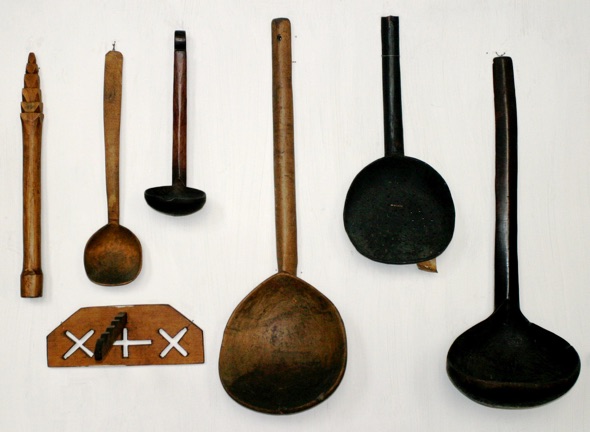Scevomorphic Motifs
Сільськогосподарські мотиви
Scevomorphic Motifs
Сільськогосподарські мотиви

The second most common group of Ukrainian motifs is those representing man-made objects: rakes, combs, ladders, windows, keys. Bread-related/agricultural motifs are included here. Selivachov appears to have coined the term “scevomorphic,” and I have been unable to find any other usages of the term, nor to determine its etymology. But it is a useful term, so I employ it.
Agricultural symbols are very common on pysanky, as Ukraine was a highly agricultural society, and drew many of its positive images from field and farm. Additionally, pysanky, as talismanic objects, were considered important in assuring the fecundity of the fields, orchard, hives and livestock.
Below are brief descriptions of many Scevomorphic motifs and symbols. For more detailed information and examples of pysanky with these motifs, go to the corresponding pages in the Scevomorphic Motifs Gallery.
LADDER
Ladders are sometimes seen on pysanky, although they are not a particularly common motif. “Drabynky” are not emphasized in Ukrainian folklore but, as Selivachov notes, they are a “universally understandable image of ascension, perfection (and) connection between heaven and earth.”


This pysanka from the Kirovohrad region has ladders incorporated into the dividing band motif:

More information about the ladder motif and symbolism here.
RESHETO
Resheto (решето) is the Ukrainian word for a cross-hatched net design which resembles grating or a sieve. Such netting is an ancient design which dates back to the Paleolithic Era (Old Stone Age, through 8000 BC), and symbolized the goddess of the sky.

According to traditional Ukrainian beliefs, the resheto has the talismanic of protection from evil spirits, and the sieve and the net are symbols of protection from evil spirits. According to Selivachov, this explains why almost every design element contains crossed lines.
The resheto is not generally a separate design element, but fills in other motifs on a pysanka: circles, squares, rhombuses, triangles. The resheto can sometimes be seen on pysanky from other parts of Ukraine, but is most beloved by the Hutsuls, including those in Bukovyna, who love to place gold and yellow resheto on their pysanky. (Most regions outside of the Carpathians prefer to fill in shapes with stripes or solid colors instead of cross-hatching.)
These simple examples of resheto are from the Kyiv region (left and center) and the Boyko area of the Carpathians (right):



More examples of resheto and information about symbolism here.
BASKET
Another scevomorphic motif found on pysanky is the basket, or koshyk (кошик). This motif is seen occasionally, and has various shapes. Traditional baskets in Ukraine vary from region to region, and come in a variety of shapes and sizes:
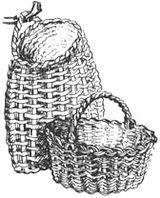

Baskets on pysanky are of two types: stylized (on folk pysanky) and realistic (on more modern pysanky). The latter have become popular in Kosmach and Illintsi in recent years, and are usually Easter baskets with a candle in them, and sometimes a paska (easter bread).


Stylized baskets can be found on folk pysanky, like these from Binyashevsky, both called “Koshyky (Кошики)” or “Baskets.”

The design on the left is a traditional one from Central Halychyna, and on the right from Zakarpattia (Transcarpathia).


More examples of baskets and information about symbolism here.
RAKES
Rakes are an agricultural symbol, but not because they are farming implements. Ukrainian rakes were made of wood, and looked like this:

Rake symbols (sometimes called combs) were very simple motifs, sometimes just a crossbar with fringe, other times a triangle with a fringe. The symbols shown here are of the first type:


The first two symbols in this row is of the triangle type of rake:

Rakes/combs are actually water symbols, and represent clouds and rain. They often are shaped like triangles, with the dashed lines representing rain itself. Sometimes the triangles are surrounded by dots, or the rakes have dots in close proximity. These dots symbolize seeds, which are watered by the rain and then grow to yield a bountiful crop.
Rakes are a very common motif on Ukrainian pysanky. These are examples of pysanky from the Vinnytsia region featuring rakes:


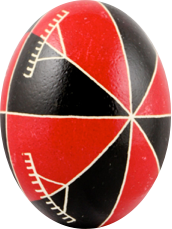
More examples of rakes and combs and information about symbolism here.
WINDOWS
“Vikontsia (віконця)” usually appear as squares (forest-steppe regions, Carpathian Mountains) or, more rarely, as elongated rectangles. In Subcarpathia, Bukovyna and Podillia, the design tends toward a rhombic (diamond) shape (below), while in Volyn and left bank Ukraine, the rectangular version is preferred.
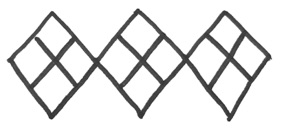
The name “window” appears to be a later-day renaming. Selivachov notes that, if you ignore the name and consider only the grapheme, a diamond or square filled with resheto, in the context of the early Bronze Age when such geometric ornamentation was being formed, it is clearly identified by archeologists as a symbol of female fertility.
WINDMILLS
A windmill (vitriak) is a cross.......in motion. It is a svarha (swastika), an ancient solar symbol. Svaroh, for who the symbol is named, was the god of the sky, the sun, and heavenly fire (thunder). The svarha depicts the movement of the sun across the sky. As Marusia Chaika notes, the swastika/svarha marked movement: good if following the sun, or evil if going against the sun.
The windmill/svarha was depicted in different ways across Ukraine.
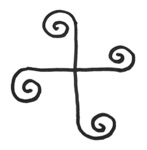
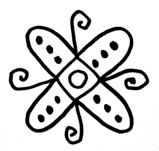
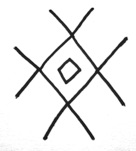
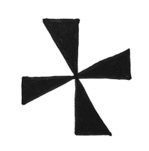
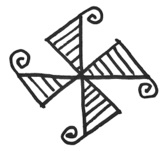
In Podillia, according to Selivachov, it was a rectangular design that resembled an actual windmill. In Bukovyna, Halychyna, Volyn and Poltava “wedged” designs predominate, giving the whole sign the appearance of a Maltese cross. In Chernhihiv the vitirak is a stylized rosette with a notched contour.
These examples only begin to hint at the varieties of expression of this motif. The first two are from Volyn; the one on the left shows the “Maltese cross” version of the svarha, while, on the right, you have a more curvilinear version. The latter design is called “Verba (Верба)” or willow, and the arms of the svarha have sprouted leaves.

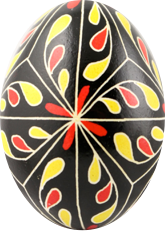
These two pysanky from Podillia are both quite interesting. The one on the left adds crowns to a simple svarha, turning it into a swirl of serpents. The one on the right transforms the svarha into a botanical motif, its center now a flower, and the arms leaves.
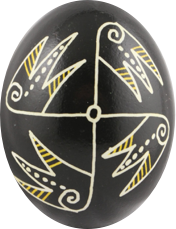
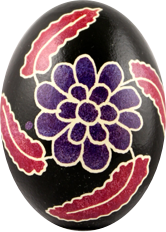
More examples of windmills and information about symbolism here.
SAW
The saw motif is also called wolves’ teeth. It is best described as a zig-zag, usually over a line. It is better discussed under zoomorphic motifs.


Examples of this motif from Bukovyna:
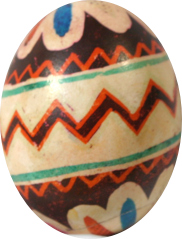
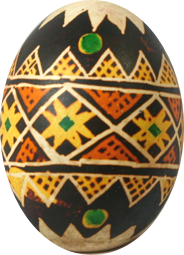
AXE
Binyashevsky, in his collection of folk pysanky, included one which he labelled with the name of “axes.” Axes do not appear otherwise in the pysanka literature, and are a motif rather than a symbol. They may simply a later renaming of an earlier symbol.
This pysanka from eastern Podillia, which is called “Wedges with axes (Клинці з сокирками)” appears to show axe heads (triangle with a dot in the middle) in concentric wedges/triangles.
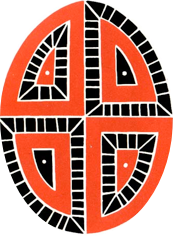
SHOVEL
A final scevomorphic motif is the shovel (spade). the zastupets (заступець) is found on one pysanka, although the motif appears to be a popular one in embroidery. This is the same pysanka, from the village of Sofiivka in the Kherson region, as depicted by Kulzhynsky and Binyashevsky, called “Zastuptsi (Заступці).”
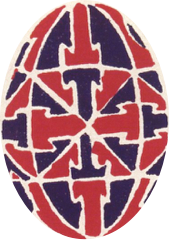
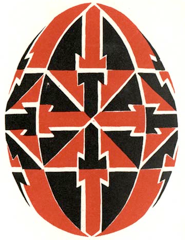
This appears to be an old cross motif, and the name may simply come from a later reinterpretation.
Back to MAIN Symbolism home page.
Back to MAIN Pysanka home page.
Back to Pysanka Index.
Search my site with Google
